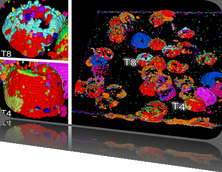Contest Tasks
This contest challenges interested participants to develop methods for comparing a large set of networks derived from rs-fMRI, each of which consists of nodes representing spatially localized brain regions and edges reflecting the strengths of functional connections between pairs of regions. The specific goal of the contest is to develop visualization methods that that help identify and understand which rs-fMRI networks, from a large provided dataset, are replicates derived from the same individuals.
Tasks
Example subjects. Beginning with the set of 5 example subjects, for whom we provide 4 networks (and corresponding region-level time series) each, participants should develop methods to quantify and visualize the similarity between pairs of networks. These networks were derived from 4 fMRI scans acquired in 2 separate sessions (pairs of scans were acquired back to back using a reversal of the phase encoding direction -- see http://humanconnectome.org/documentation/).
The notion of similarity may be defined differently by individual participants, but a chief objective should be to find the “similarity space” that minimizes differences between replicate networks of the same individual and highlights differences between networks derived from different individuals.
Participants may consider a number of different strategies and different “features.” For example, correlation values may be considered as edge weights in a fully connected graph, or edges may be thresholded and binarized. Edge weights could be treated as individual features, or participants may wish to apply graph and network analytic tools to derive additional properties from each graph. Participants may also choose to construct networks from the provided region-level time series data using alternative methods; however, entries should maintain a focus on network structure rather than a different formulation.
Participants may focus on any or all of the tasks below.
Task 1. Participants should identify those properties of the networks that are most consistent across the population of subjects provided, and those that are most variable. Entries should provide quantification of these results. For this task, participants should consider networks from the 5 example subjects (with identified replicate scans) as well as the networks provided from 18 additional unique subjects.
Task 2. This is the primary objective challenge in the contest. Participants should “match” the 30 provided test networks to the corresponding contest subject networks (i.e., determine the pairs of networks derived from the same individuals). Note that each of the 18 “contest subjects” are represented at least once in the test data. Entries should include a description of what features and measures of similarity were used to determine these matches.
Task 3. Participants should develop visual tools that allow researchers to explore the similarity / dissimilarity between individuals in the population of subjects provided in a “natural” space that reflects the anatomical / spatial properties of the human brain. In particular, such tools should allow a user to visually examine the features of these networks in individual subjects and across the population. Entries should provide demonstration of the tools in meaningful use cases, such as those outlined in Task 1 and Task 2.
Judging. Entries will be, in part, scored based on the accuracy and completeness of their answers to the questions proposed in the contest tasks above. In addition to this aspect of scoring, judges will also consider factors including, but not limited to: the extent to which the correctness of an answer is supported or evident from the visualization/analysis presented in the entry; the appropriateness of visualization or informatics approaches applied; and the potential for usability of the approach in the community. As with previous BioVis contests, an entry does not need to complete all, or any tasks, to be competitive. Entries which focus on specific aspects of the problem, and which provide unique and valuable contributions to the rs-fMRI field - from design studies to unique visualization methods - are welcome, and are likely to be scored favorably.






